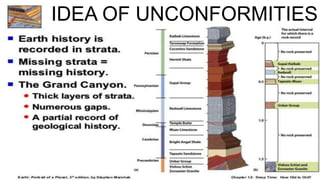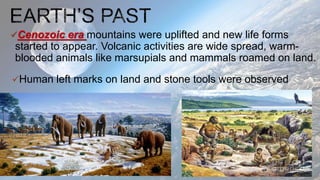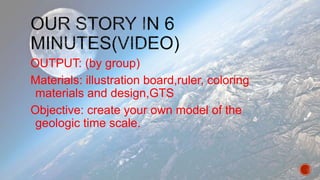Earth History ppt
- 3. I believe that the more you know about the past, the better you are prepared for the future.
- 6. The major assumption of Geology Events of the past occurred the same way that they are occurring today.
- 7. Used to determine whether an object or event is older or younger than other objects or events. Tool: Sedimentary rocks They are formed from the fragments of other rock types. New sedimentary rocks are flat.Fossils are deposited in these rocks
- 13. Used to measure the absolute age of an object or event by analyzing isotopes of radioactive elements. Tool: Radioactive IsotopesIsotopes-Atoms of the same element that have similar # of p+ but different # of n⁰. Unstable isotopes that break down stable isotopes and/ or elements-Radioactive Decay
- 15. Time needed for half of a sample of a radioactive substance to undergo radioactive decay.
- 16. PARENT ISOTOPE HALF- LIFE STABLE DAUGHTER Uranium-235 704 million years Lead-207 Uranium-238 4.5 billion years Lead-206 Potassium-40 1.25 billion years Argon-40 Thorium-232 14.0 billion years Lead-208 Lutetium-176 35.9 billion years Hafnium-176 Rubidium-87 48.8 billion years Strontium-87 Samarium-147 106 billion years Neodymium-143
- 17. 1. An Ancient bone was found and analyze. It contain Potassium-40 that have decayed for nearly 2 half- lives. How old is the bone? 2. An igneous rock contains ½ of its original amount of Potassium-40. how old is the rock? 2.5 billion years 1.25 billion years 3. If Strontium-147 is cut into pieces,what would be the half- life of each piece?
- 18. Indicates the life forms present in different periods. System used by scientists to relate stratigraphy and time to any geologic events.
- 20. GEOLOGIC TIME SCALE (GTS) BOOK PAGE 64 EON ERA PERIOD EPOCH AGE PHANEROIC CENOZOIC QUATERNARY HOLOCENE 0.1 PLEISTOCENE 1.8 TERTIARY PLIOCENE 5.3 MIOCENE 23.0 OLIGOCENE 33.9 EOCENE 55.8 PALEOCENE 65.5 MESOZOIC CRETACEOUS 145 JURASSIC 200 TRIASSIC 251 PALEOZOIC PERMIAN 299 PENNSYLVANIAN 318 MISSISSIPPIAN 359 DEVONIAN 416 SILURIAN 444 ORDOVICIAN 488 CAMBRIAN 542 PRECAMBRIAN PROTEROZOIC BACTERIA & BLUE-GREEN ALGAE 2500 ARCHEAN OLDEST FOSSILS 3800
- 21. Precambrian is roughly 4.1 billion years ago were 88% of the Earth’ history happened. The perceived harshness of the primordial Earth happened during Hadean(chaotic eon)- bombardment of meteorites and severe volcanic activities. During this era, ocean and atmosphere were formed. The crust and core was also stabilized.
- 22. Archean was when the Earth became warm but the atmosphere contain only methane with little to no oxygen (orange atmosphere). Most of Earth was still covered with water. Oceans were green due to abundance of iron and stromatolites.
- 23. Proterozoic era was when the atmosphere began to have oxygen, eukaryotes diversified, multicellular animals spread and continents began to drift away. Paleozoic era was when fossils of marine invertebrates(trilobites and brachiopods) were formed in sedimentary layers.
- 24. During the middle Paleozoic era, marine life forms developed shells. During the Devonian period, animals began to breathe air as amphibians came out of the sea and land plants develop. During the late Paleozoic era, reptiles appear were they lay eggs on the ground. Coal deposits
- 25. Mesozoic era marks the break up of major land masses. Largest creatures were believed to appear in this era which are descendants of reptiles in the Paleozoic era (dinosaurs)
- 26. Cenozoic era mountains were uplifted and new life forms started to appear. Volcanic activities are wide spread, warm- blooded animals like marsupials and mammals roamed on land. Human left marks on land and stone tools were observed
- 27. OUTPUT: (by group) Materials: illustration board,ruler, coloring materials and design,GTS Objective: create your own model of the geologic time scale.


























